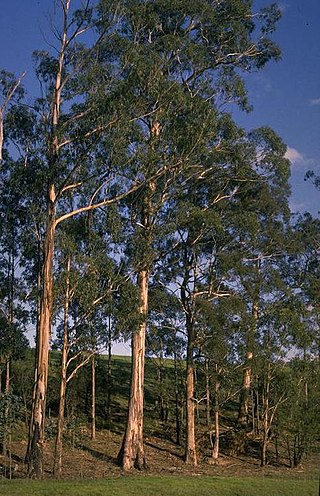
Acacia s.l., known commonly as mimosa, acacia, thorntree or wattle, is a polyphyletic genus of shrubs and trees belonging to the subfamily Mimosoideae of the family Fabaceae. It was described by the Swedish botanist Carl Linnaeus in 1773 based on the African species Acacia nilotica. Many non-Australian species tend to be thorny, whereas the majority of Australian acacias are not. All species are pod-bearing, with sap and leaves often bearing large amounts of tannins and condensed tannins that historically found use as pharmaceuticals and preservatives.

Scopolamine, also known as hyoscine, or Devil's Breath, is a natural or synthetically produced tropane alkaloid and anticholinergic drug that is used as a medication to treat motion sickness and postoperative nausea and vomiting. It is also sometimes used before surgery to decrease saliva. When used by injection, effects begin after about 20 minutes and last for up to 8 hours. It may also be used orally and as a transdermal patch since it has been long known to have transdermal bioavailability.

The Rutaceae is a family, commonly known as the rue or citrus family, of flowering plants, usually placed in the order Sapindales.

Robinia pseudoacacia, commonly known in its native territory as black locust, is a medium-sized hardwood deciduous tree, belonging to the tribe Robinieae of the legume family Fabaceae. It is native to a few small areas of the United States, but it has been widely planted and naturalized elsewhere in temperate North America, Europe, Southern Africa and Asia and is considered an invasive species in some areas, such as the temperate east coast of Australia where the cultivar 'Frisia'(Golden Robinia) was widely planted as a street tree before being classed as a weed. Another common name is false acacia, a literal translation of the specific name.

Erythrina is a genus of plants in the pea family, Fabaceae. It contains about 130 species, which are distributed in tropical and subtropical regions worldwide. They are trees, with the larger species growing up to 30 m (98 ft) in height. The generic name is derived from the Greek word ερυθρóς erythros, meaning "red", referring to the flower color of certain species.

Averrhoa carambola is a species of tree in the family Oxalidaceae native to tropical Southeast Asia; it has a number of common names, including carambola, star fruit and five-corner. It is a small tree or shrub that grows 5 to 12 m tall, with rose to red-purple flowers. The flowers are small and bell-shaped, with five petals that have whitish edges. The flowers are often produced year round under tropical conditions. The tree is cultivated in tropical and semitropical regions for its edible fruits.

Eucalyptus globulus, commonly known as southern blue gum or blue gum, is a species of flowering plant in the family Myrtaceae. It is a tall, evergreen tree endemic to southeastern Australia. This Eucalyptus species has mostly smooth bark, juvenile leaves that are whitish and waxy on the lower surface, glossy green, lance-shaped adult leaves, glaucous, ribbed flower buds arranged singly or in groups of three or seven in leaf axils, white flowers and woody fruit.

Agonis flexuosa is a species of tree that grows in the southwest of Western Australia. It is easily the most common of the Agonis species, and is one of the most recognisable trees of Western Australia, being commonly grown in parks and on road verges in Perth.

Acacia, commonly known as the wattles or acacias, is a genus of about 1084 species of shrubs and trees in the subfamily Mimosoideae of the pea family Fabaceae. Initially, it comprised a group of plant species native to Africa, South America and Australasia, but is now reserved for species mainly from Australia, with others from New Guinea, Southeast Asia and the Indian Ocean. The genus name is Neo-Latin, borrowed from the Greek ἀκακία, a term used by Dioscorides for a preparation extracted from the leaves and fruit pods of Vachellia nilotica, the original type of the genus. In his Pinax (1623), Gaspard Bauhin mentioned the Greek ἀκακία from Dioscorides as the origin of the Latin name.

Didymeles is a genus of flowering plants. It is variously treated as the only genus of the family Didymelaceae — or in the family Buxaceae, as in the APG IV system.

The Proteaceae form a family of flowering plants predominantly distributed in the Southern Hemisphere. The family comprises 83 genera with about 1,660 known species. Australia and South Africa have the greatest concentrations of diversity. Together with the Platanaceae, Nelumbonaceae and in the recent APG IV system the Sabiaceae, they make up the order Proteales. Well-known 'Proteaceae genera include Protea, Banksia, Embothrium, Grevillea, Hakea and Macadamia. Species such as the New South Wales waratah, king protea, and various species of Banksia, Grevillea, and Leucadendron are popular cut flowers. The nuts of Macadamia integrifolia are widely grown commercially and consumed, as are those of Gevuina avellana on a smaller scale.
Pituri, also known as mingkulpa, is a mixture of leaves and wood ash traditionally chewed as a stimulant by Aboriginal Australians widely across the continent. Leaves are gathered from any of several species of native tobacco (Nicotiana) or from at least one distinct population of the species Duboisia hopwoodii. Various species of Acacia, Grevillea and Eucalyptus are burned to produce the ash. The term "pituri" may also refer to the plants from which the leaves are gathered or from which the ash is made. Some authors use the term to refer only to the plant Duboisia hopwoodii and its leaves and any chewing mixture containing its leaves.

Bursaria is a genus of eight species of flowering plants in the family Pittosporaceae and is endemic to Australia. They are shrubs or slender trees, often with spiny branches and have simple leaves, relatively small flowers with five sepals, five petals and five stamens, and fruit that is a flattened, thin-walled capsule.

Styphnolobium japonicum, the Japanese pagoda tree is a species of tree in the subfamily Faboideae of the pea family Fabaceae.

Melaleuca viridiflora, commonly known as broad-leaved paperbark, is a plant in the myrtle family Myrtaceae, and is native to woodlands, swamps and streams in monsoonal areas of northern Australia and New Guinea. It is usually a small tree with an open canopy, papery bark and spikes of cream, yellow, green or red flowers.

Duboisia myoporoides, or corkwood, is a shrub or tree native to high-rainfall areas on the margins of rainforest in eastern Australia. It has a thick and corky bark. The leaves are obovate to elliptic in shape, 4–15 cm long and 1–4 cm wide. The small white flowers are produced in clusters. This is followed by globose purple-black berries.

Duboisia hopwoodii is a shrub native to the arid interior region of Australia. Common names include pituri, pitchuri thornapple or pitcheri.

The Solanaceae, or the nightshades, are a family of flowering plants that ranges from annual and perennial herbs to vines, lianas, epiphytes, shrubs, and trees, and includes a number of agricultural crops, medicinal plants, spices, weeds, and ornamentals. Many members of the family contain potent alkaloids, and some are highly toxic, but many—including tomatoes, potatoes, eggplant, bell and chili peppers—are used as food. The family belongs to the order Solanales, in the asterid group and class Magnoliopsida (dicotyledons). The Solanaceae consists of about 98 genera and some 2,700 species, with a great diversity of habitats, morphology and ecology.

Halfordia is a genus of plants in the family Rutaceae containing the single species Halfordia kendack commonly known as kerosenewood, southern ghittoe or saffronheart, is a rainforest plant that is native to eastern Australia, New Guinea and New Caledonia. It is a shrub or tree with elliptical to egg-shaped leaves with the narrower end towards the base, panicles of white, greenish white or yellowish flowers and purple to bluish black, spherical to oval fruit.

















